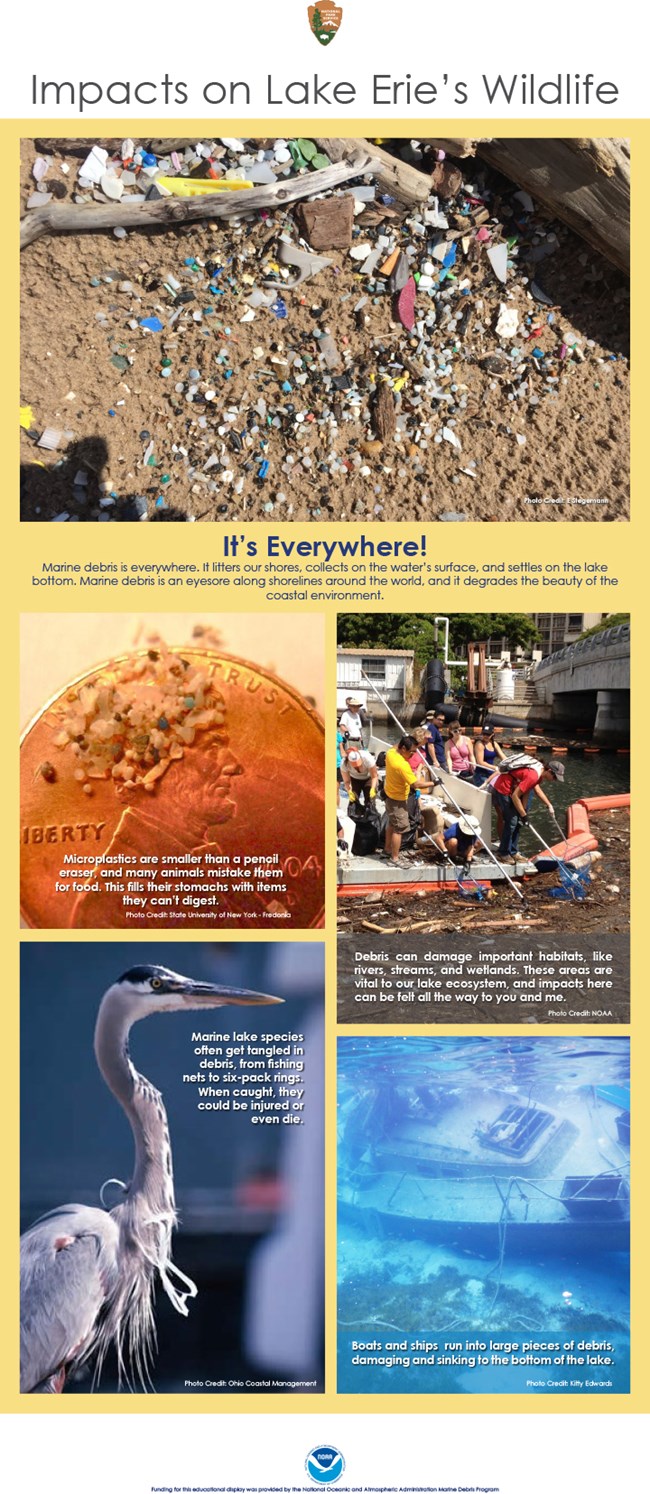

Impacts on Lake Erie’s WildlifeIt’s Everywhere!Marine debris is everywhere. It litters our shores, collects on the water’s surface, and settles on the lake bottom. Marine debris is an eyesore along shorelines around the world, and it degrades the beauty of the coastal environment.Microplastics are smaller than a pencil eraser, and many animals mistake them for food. This fills their stomachs with items they can’t digest. Marine lake species often get tangled in debris, from fishing nets to six-pack rings. When caught, they could be injured or even die. Debris can damage important habitats, like rivers, streams, and wetlands. These areas are vital to our lake ecosystem, and impacts here can be felt all the way to you and me. Boats and ships run into large pieces of debris, damaging and sinking to the bottom of the lake.

What is Marine Debris?Marine debris is anything solid and man-made, including litter, that is lost or thrown into the marine and Great Lakes environment. Once in the environment, plastic marine debris breaks up into smaller and smaller fragments, but never fully goes away. Because so many of the things we use and produce are made of plastic, it is one of the most common types of marine debris found in the ocean and Great Lakes.Lake Erie’s future depends on our actions to improve this natural habitat now!

Impacts on Lake Erie’s EconomyTourism & RecreationThe largest employer in the Great Lakes economy is the tourism and recreationsector, which relies heavily on healthy coastal resources and a clean, beautiful environment. Unfortunately, marine debris is a pervasive issue in many coastal areas of the United States. Does Marine Debris Affect the Economy?Imagine you’ve just planned a family trip to the beach, but when you arrive, you find a beach littered with debris. Would you stay and play, or be on your way? A recent study of beachgoer behavior helps us understand the potential economic effects of marine debris on the coastal tourism economy.
How Can You Help?11 MillionThe shores and islands of Lake Erie see nearly 11 million visitors every year, who can generate a lot ofmarine debris. If every visitor committed to do better, imagine how much cleaner our lake would be. Commit to helping reduce marine debris no matter where you are. We can all be part of the solution! You Can Help... at HomeYou can help from your own home. You can buy in bulk and use reusablecontainers. Many plastic items can be recycled or used again. Whenever you reuse or use less, you create less waste that can potentially become marine debris. You Can Help... On the WaterYou can properly stow and secure all trash on your boat and recycle your fishing line. Remember that it is illegal to dispose of any garbage in all U.S. waters and anywhere at sea.You can report illegal dumping to your local U.S. Coast Guard. You can support environmentally responsible marinas that participate in Clean Marina programs, which offer sufficient waste and recycling receptacles, including places to recycle fishing line. You Can Help... On the ShoreYou can easily join the cleanup effort by picking up garbage and throwing it away in the proper trash or recycling bin. Look for 3 things between your car and beach blanket to make a big difference!Help document debris in your community with the Marine Debris Tracker app. Knowing more about the different types of debris found on a beach, or even on your street, is the first step towards preventing it. 
Pledge to Help“I pledge to do my part to protect Lake Erie”Use reusable straws Use reuseable shopping bags Recycle my fishing line Pick up 3 pieces of litter Properly dispose of cigarette butts YOU can make a difference!
Did You Know?Not all Plastics float! Many break down and sink to the bottom causingproblems for wildlife and the environment At least one third of all seabird species eat debris Cigarette butts are made of a plastic-like material that doesn’t degrade Worldwide, more than 350 Species of wildlife become entangled in debris Plastic is the most common type of marine debris in the ocean and Great Lakes Plastic does not biodegrade in water You can volunteer to clean up the lake 11 Million people get their drinking water from Lake Erie. Let’s keep it clean! You can Tie things down when you are boating, so your items will not become marine debris You can Pick Up more garbage than you make |
Last updated: June 25, 2021
